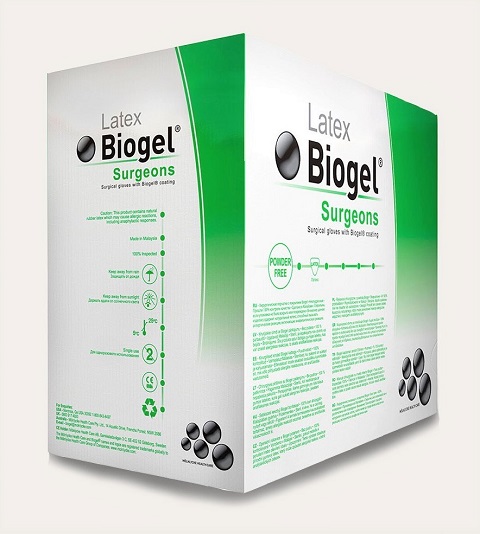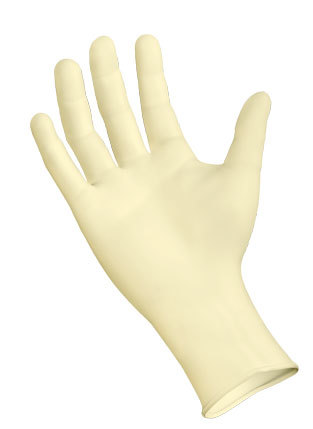 Loading... Please wait...
Loading... Please wait...Free Shipping on orders over $400
Categories
8 Things to Consider When Buying Surgical Gloves
Posted on 12/24/2018 10:17:34

Protecting your surgical team from pathogens present in blood and other body fluids is imperative for keeping everyone safe and preventing the spread of transmittable illnesses. The type of sterilized surgical gloves you provide is key in setting up the first line of defense as part of your team's personal protective equipment.
You can buy surgical and medical gloves made from a wide variety of materials, ranging from neoprene, vinyl, nitrile rubber, latex and more. Each material has its pros and cons, and there are other considerations you should keep in mind when purchasing surgical rubber gloves. Overall, surgical gloves should be evaluated based on their safety, cost and clinical efficacy before purchase and use.
8 Things to Consider When Buying Surgical Gloves
1. Glove Material
2. Powdered vs. Unpowdered
3. Double-Gloving
4. Compatibility with Existing Products
5. Procedure-Related Requirements
6. Level of Protection
7. Fit and Comfort
8. Overall Quality vs. Cost
What are Surgical Gloves?
Classified as medical devices, surgical gloves are the highest-grade category of medical gloves and a key component of your team's surgical supply cabinet. As a comprehensive category, medical gloves are used whenever there is a chance of your team having contact with bloodborne pathogens or other environmental contaminants. Since the risk associated with such procedures and environments is so high, medical gloves are tested rigorously and must meet specific guidelines set forth by the Food and Drug Administration, particularly related to the acceptable quality level for pinholes. Sterile surgical gloves will have a lower pinhole acceptable quality level than other categories of non-sterile gloves.
In general, surgical gloves are higher quality than general medical or exam gloves. Surgical gloves are designed specifically to provide high tensile strength, plus the tactile feel, sensitivity, and accuracy that surgical teams require.

History of Surgical Gloves
Surgical gloves became available in the early 1840s, but many surgeons were reluctant to wear them because they were uncomfortable, inflexible, and generally non-functional for some time. In 1878, Thomas Forster of the India-Rubber Works in Surrey, England, received a patent to manufacture gloves specifically for surgical operations.
Not surprisingly, as surgeons learned more about bacteriological contamination, wearing surgical gloves became more common. Historical records don't show who was the first to require surgical gloves for all surgical procedures. However, we do know that by 1878, a New York City gynecologist named T. Gaillard Thomas allowed select members of his surgical staff to wear surgical gloves in order to protect their hands from the effects of the harsh chemicals used to clean their surgical instruments.
For quite some time, most surgeons allowed their teams to wear surgical gloves while they themselves remained bare-handed in the operating room in order to preserve their desired level of delicacy, touch, and tactile sensitivity. At the time, most surgeons believed that effective hand-washing was sufficient to protect patients from wound infection. However, a clinical study by German scientist Bernard Kronig in the mid-1890s revealed that hand-washing alone was insufficient protection. Interestingly, even with this evidence-based recommendation, the widespread and international adoption of sterile surgical gloves as a necessity did not occur until after World War I.
8 Things to Consider When Buying Surgical Gloves
1. Glove Material
Latex
For many years, natural rubber latex has been the material of choice for disposable surgical gloves. Latex offers a high level of performance, comfort, and flexibility, and also fits a variety of glove types and sizes. Latex gloves offer a variety of benefits: They are typically easy for the team to put on, and many brands include a polymer coating that replaces the traditional cornstarch powder inside. Many surgical teams report that latex surgical gloves offer the most comfortable and flexible fit and provide a high level of sensitivity. Additionally, latex offers an effective barrier against pathogens and contaminants. Some surgeons have even described latex as fitting "like a second skin," and latex surgical gloves also endure in long and complicated procedures. Because latex is a natural rubber fiber, latex surgical gloves are also biodegradable.
However, as more and more patients are diagnosed with latex allergies, latex surgical gloves have become less of a popular option. In fact, many organizations, including the National Institute for Occupational Safety and Health, now recommend non-latex, or synthetic, surgical gloves in order to protect patients from potential allergic reactions to latex. There is some evidence that consistent and prolonged exposure to latex also can encourage latex allergies to develop. And because latex is a natural product, fluctuating natural material costs can fluctuate rapidly, which can cause your costs to change unpredictably.
Nitrile
Some teams have moved to surgical gloves made of nitrile, which is a synthetic rubber fabric that offers a latex-free option. They are stronger than latex or vinyl and boast the best resistance to needle sticks and abrasions. Nitrile gloves are often used as an appropriate alternative for those with latex allergies. These non-latex surgical gloves offer higher barrier protection from exposure to chemicals and can mold to the surgeon's hand for a comfortable fit.
A nitrile glove has a very long shelf life, so you can feel confident in ordering a large quantity that will keep well. Nitrile surgical gloves also are available in both blue and black surgical gloves, which can be advantageous to surgical teams who prefer to double-glove. Colored gloves help identify if a glove has been torn or punctured. The only disadvantages of sterile nitrile surgical gloves are that the material dissolves when it comes into contact with acetone, and disposable nitrile gloves are not available in powder-free versions.
Vinyl
Medical gloves made from vinyl are available but should be relegated to examination gloves only. Vinyl gloves are inexpensive and latex-free for those with latex allergies, but they also are less durable and more likely to suffer punctures and tears. In fact, vinyl gloves offer the lowest level of both chemical and puncture resistance overall. In addition, they are less elastic than either disposable nitrile or latex, which means your team sacrifices comfort, flexibility, and overall fit when you choose vinyl gloves. They also have limited application within a surgical site. When using vinyl gloves, your team also will need to change gloves frequently because of the limitations listed above.
2. Powdered Gloves vs. Unpowdered
Historically surgical teams preferred powdered disposable gloves, which typically contained cornstarch inside, making them easier to slip over hands. While the ease of use was certainly one benefit of using powdered surgical gloves, the powder itself could create complications if it comes in contact with exposed tissue during a procedure or surgical incision. In some cases, contact with the powder resulted in infection and slowed down the overall healing process. Because of these challenges and the FDA ban on powered surgical gloves, surgical procedures require gloves to be powder-free. The USA FDA banned use of powered surgical gloves on January 19, 2017. Many manufacturers now employ specific processes to make sure powder-free gloves have the same easy on/off feel as those with powder.
3. Double-Gloving
Some surgical teams prefer the practice of double-gloving – wearing two sets of surgical gloves in order to maximize protection. This practice can dramatically reduce the risk of infection for everyone involved in a surgical procedure. In fact, one clinical study has shown that the double-gloving practice can reduce exposure to bloodborne pathogens by as much as 87 percent, even when the outer glove suffers a puncture. If your team wears two different-colored surgical gloves, they can become aware even more quickly when the outer glove is punctured. For example, many surgical teams choose to wear a lighter-colored pair of gloves under a darker one (or the opposite) so that perforations and tears are easy to spot quickly.
The Centers for Disease Control and Prevention and the Occupational Safety and Health Administration, plus the American College of Surgeons, all recommend the practice of double-gloving. If you decide to go this route, you'll need to ensure that you place an order large enough to support this practice, and you'll need to make a point to purchase undergloves as well as the outer versions.
Please note that many surgeons and surgical staff weren't trained to double-glove, so going in this direction may involve a paradigm shift for your team, and you'll need to plan training accordingly.
4. Compatibility with Existing Products
You'll want to make sure that the gloves you select are compatible with other, existing surgical products in your operating room – everything from surgical lights to surgical blades. A good way to do this is to study several surgical gloves and have your surgical team give them a "test run," using the existing operating room supplies.
5. Procedure-Related Requirements
Your surgical team may require a specific type of glove, depending on the rigors and requirements of a particular procedure. In addition, you'll want to consider the unique needs of each patient, especially if a latex allergy is a possibility.
6. Level of Protection
You must consider the type and level of protection your team is most likely to need on a regular basis, along with understanding the specific barrier requirements associated with various procedures. When it comes to selecting the level of protection, you can consider features like thickness, puncture resistance and tensile strength to help guide your surgical gloves purchase.
7. Fit and Comfort
Of course, the most important feature to consider when purchasing sterile surgical gloves is how well they protect the surgical team and the patient, but you can't completely ignore fit and comfort. You want your team to feel confident and at ease during surgery. Having gloves that fit well and are comfortable, especially during long or challenging procedures, can help set up your surgical team for success. Many manufacturers offer surgical gloves size charts on their websites. The helpful staff at USA Medical and Surgical Supplies is happy to consult with you to ensure you choose the right glove size that is comfortable for your team.
8. Overall Quality vs. Cost
You have to consider both quality and cost when making your surgical glove selection. You want a good value, but that doesn't mean choosing the least expensive option. You have to weigh the quality and end-user requirements against the sale price to determine your best value. Talk with your team and get their feedback before making your surgical glove purchase.
The Importance of Surgical Gloves
Sterile surgical gloves carry a heavy burden within your operating room. They protect the wearer and the patient from contamination, prevent bacteria and other pathogens from entering the sterile surgical work area, and they protect the wearer from various chemicals used in the operating room. In order to protect against infection, sterile surgical gloves should meet infection prevention requirements in both directions – protecting the medical professional and the patient.
There are many good surgical gloves available today to match a wide range of surgical procedures and budgets. Ansell and Molnlycke Health Care (the manufacturer of the widely used Hibiclens soap ) produce the feature rich and advanced surgical gloves. Innovative Healthcare and Sempermed produce high quality surgical gloves at the middle price tiers.

One of the most widely used surgical gloves is the Ansell Encore Perry Style 42 surgical gloves . The Ansell Encore Perry Style 42 surgical gloves have been available for many years and the latest version is powder-free. The Molnlycke Health Care Biogel Surgeons surgical gloves are also widely used for surgical procedures. The Biogel Surgeons surgical gloves have a unique Biogel coating on the inner surface, curved finger design, and micro-roughed surface. The Ansell Encore Latex surgical gloves feature Ansell’s SureFit technology and they have a textured surface.

The Innovative Healthcare NitriDerm Nitrile surgical gloves are not made with latex and they are soft and highly elastic. The NitriDerm Nitrile surgical gloves are one of the most cost-effective, high-quality gloves. The Innovative Healthcare DermAssist Prestige Chloroprene surgical gloves are manufactured from polychloroprene (a non-latex synthetic polymer). The DermAssist Prestige Chloroprene surgical gloves provide the comfort and flexibility of a latex glove without the risk of problems with latex allergies. The Sempermed Supreme Latex surgical gloves are anatomically designed to reduce hand fatigue and increase comfort and they have a micro textured surface that provides extra grip.

If you have questions about which surgical gloves to consider, reach out to our staff. We have decades of experience researching and recommending medical supplies and equipment. Contact us if you have any questions about the right equipment or supplies. E-mail us on our Contact form or call us toll-free: 1-866-561-2380.



